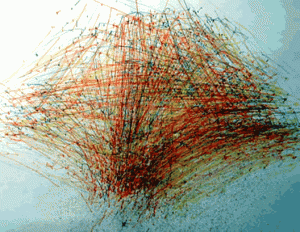Rhizome Radar by Peter Nowicki
It is hard to identify what is the central theme of the Duleuze’s and Guattari’s A Thousand Plateaus: Capitalism and Schizophrenia, but perhaps suggesting centrality is probably the opposite of the message the book advocates. The book is a distinctive model both in it’s ‘non-structured’ writing methodology but also in its call for a different way of thinking and being, in which the concept of rhizome is introduced. The writing allows for interpretation and connections with many subjects or thoughts, and one can easily relate it with architecture especially emerging theories such as parametricism. Many comparisons have been theorised between Deleuze and Guattari’s rhizome model and other emergent like cyberspace and computer networks which started occuring most noticably after the later 1980s. A Thousand Plateaus is an example of such open systems. It advocates an intellectual message in which the only rule would be the avoidance of the rule. The only rules it employs are those required in order to construct a wide array of concepts such as rhizomatic, non- linearity, nomadism, mutiplicity and anarchism. Clear definitions are are highlighted with capital letter, “RHIZOMATICS = SCHIZOANALYSIS = STRATOANALYSIS = PRAGMATICS = MICROPOLITICS”
The first chapter describes what a rhizome model is.The rhizomatic thinking way is the opposite of what informs most of modernist western thought, and approaches taken with science, architecture, urban planning and theology to name a few. To get a better understanding of what a ‘rhizome’ is, the authors describe what the opposite of a rhizome is. The ‘anti-rhizome’ is represented as a tree-like structure, with branches that continue to subdivide into smaller and lesser branches. Something structured with a beginning and end, with traced knowledge of what the end should be. Rhizomatic thought is the opposite- non-linear, anarchic, and nomadic, with an unknown conclusion or beginning.
The rhizome presents a series of rhizomatics principles. The first two are the principles of connection and heterogeneity, where a rhizome is a network which can be connected to anything at any point. The third principle is multiplicity, where a rhizomatic system is composed of a multiplicity of lines and connections, unlike those found within a structure a tree, such as the roots, trunk and branches.The fourth principle is Asignifying Rapture, meaning that in a rhizomatic network, movements and flows can be re-routed around disruptions.
The fith and sixth principles: Cartograpphy/ Decalcomnia. The rhizome is distinguished from a tracing, and is referred to as a mapping. The western world based on rational and logical approaches, and the making of structured patterns and tracings is questioned. A tracing is believed to be genetic; it evolves and reproduces from earlier forms. On the other hand, maps are open systems “The map is open and connectable in all of its dimensions; it is detachable, reversible, susceptible to constant modification. It can be torn, reversed, adapted, to any kind of mounting, reworked by an individual, group, or social formation.” All codification and rules are tracings.
An interesting area of study would be applying the rhizome methodology in architecture education. Architecture is deemed to be a creative art. On the other hand, unlike other arts like music and painting, it is a service oriented profession. Not only, architecture is guided by other forces which could be political, economical, technological and social. Such is the complexity of the architectural profession and education. Most architectural education is bound with a set curriculum with little or no room for innovative strategies. Perhaps architecture education should be redefined and more rhizomatic and open ended approach could be employed.

